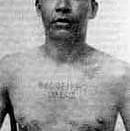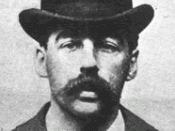When Son of Sam first struck on the morning of July 29, 1976, no one could expect that a serial killer was making his debut. Two young women, Donna Lauria, an eighteen-year-old brunette, and her nineteen-year-old friend Jody Valenti, were talking in Jody's car near the entrance of the Lauria's apartment building in the Bronx, New York City. As they were talking, a man came beside the car and pulled out a Charter Arms .44 Bulldog handgun from a paper bag; he squatted down and fired into the car five times. Shot in the neck, Donna died immediately. Jody, shot in the thigh, leaned on the horn while the man continued to pull the trigger, even though the chamber was empty (Klausner).
This act was just the beginning for David Berkowitz. Police could find no motive for the attack. Finally, they theorized that it night have been either a mob execution with mistaken victims or a lone psycho.
However, in the months to come they would find out they were terribly wrong. It was not until three months later that the Son of Sam struck again, and continued to strike on a month-to-month spree. In all cases, the survivors say a man approached then either in their car or on the street near their house and pulled a gun on them. Police were not yet able to link these attacks to a single individual. Things quieted for two months, and then in the early hours of January 30, 1977, the killer went hunting for his next victim. After the fourth killing the police had two theories: the killer was either psychotic or someone who had something against Christine Freund, his last victim. After further investigation, they discovered that her murder matched those other assaults on Donna Lauria, Donna LaMasi, and Joanne Lomino. They had a hunch they were dealing with one psycho packing a .44, stalking women in various parts of the city. The police were unable to find a suspect or a third party person all the girls had in common. It was beginning to look as though a psycho had randomly targeted attractive young women for assassination. The following day, the police commissioner held a press conference to announce to the City of New York that they had linked the various shootings, and put emphasis on finding this individual before he killed again (Klausner).
Then, on his April 17, 1977 killing, he left a letter addressed to Captain Borrelli. In the letter, the killer gave the police his "name"- Son of Sam. After the letter was left, New York City Mayor Abraham Beame called what he saw as a much needed press conference to discuss the Son of Sam case. As soon as the case went public, the police were flooded with calls; everyone thought they knew the killer. They got their final lead when a man came forward and said he had received a letter with the same writing as the Son of Sam letter, from a man who shot his dog. Police finally found their killer and identified him as David Berkowitz (Klausner).
On August 10, Shea Strano, William Gardella, and John Falotico put Berkowitz's street under surveillance. The number of cops grew, as everyone wanted to be in on the arrest. Several hours after they arrived, a figure emerged from the apartment building, carrying a paper bag. The police surrounded the car and told the man to freeze. He turned around and smiled idiotically at them. They instructed him to get out of the car, and the man obeyed, still smiling. Then when asked to identify himself, he said, "I'm Sam. David Berkowitz. What took you so long?" (Klausner)
The defense psychiatrist classified Berkowitz as a paranoid schizophrenic. They believed that his difficulties relating to people drove him further into isolation, and the isolation was a fertile ground for wild fantasies. Eventually, the fantasies crowded out reality and David lived in a world populated by the demons his mind had created. As his state of mind deteriorated, tension grew and was only released when he successfully attacked someone. For a brief time, the assaults relieved the tensions, but the tensions began to increase again, and the cycle repeated itself. David believed demons were commanding him to kill. Ultimately, it did not matter because David Berkowitz pleaded guilty, and was sentenced to 365 years in prison (Klausner).
After 25 years in prison, David Berkowitz's first parole hearing was conducted at the place of Berkowitz's incarceration in July 2002 (Klausner). He was one of our nation's most infamous serial killers and is now having a parole hearing to see if he is allowed to go back out into the world. Even though David has successfully completed prison rehabilitation programs, it is not possibly to rehabilitate a serial killer because they have mental conditions beyond repair, they possess illnesses that can be treated but not cured, and due to the massive amount of sentencing they have, they should never be released.
Idealistic individuals, like Mother Teresa, believe serial killers should be rehabilitated while they are in prison, so they can be "cured" of their illness (Jagtiani). However, it is a waste of time and money to try to rehabilitate serial killers, because few, if any, will ever get out of prison. They are sentenced to massive amounts of time in prison, with virtually no chance of parole. It does not seem worth the time and money to help these killers if they will never get out. For Berkowitz, he is sentenced to 365 years in prison, way beyond any person's natural life. He claims he is rehabilitated, and he may be, but he is still denied parole at his 2002 hearing. Even if he is rehabilitated, sue to the length of his sentence and the severities of his crimes, this individual, and many like him will probably never be paroled.
Most serial killers cannot be rehabilitated or released because they have mental conditions beyond repair. Almost all serial murderers are diagnosed after they are apprehended, as sociopaths, psychopaths or schizophrenic. These conditions are certainly treatable, but with great difficulty. There has been no proven success for these treatments in serial killers (Abrahamsen).
Sociopaths, Psychopaths, and schizophrenics are all treatable, but not changeable. It is not possible to treat, cure, and change a person with these medical conditions. Sociopathic individuals have little regard for the feeling and welfare of others. One symptom is they do not learn from experience. Therefore a killer that has murdered and has been caught does not learn from that and when he is released from prison he kills again (Jimeny). Psychotherapy, group therapy, and family therapy are common treatments; the effects of all medical treatments are inconclusive; because no one has successfully completed treatment. Psychopaths create a gulf between themselves and the rest of the world; they are believed to be victims of neurobiological behavioral abnormalities (Martens). It is possible to diminish some traits like sensation seeking and impulsivity, but almost impossible to diminish their aggression and emotional pain. There have been no controlled studies to date of successful psychopharmacological treatment. There have been successful cases of controlling schizophrenia, jut only in less severe cases ("Schizophrenia Treatments").
People think once a serial killer is rehabilitated he or she can be sent back into the world and mix with other people. But, it is simply not possibly for a serial killer to rehabilitate, because a person cannot gain a super ego after a certain age. It is generally true that a person's character is not susceptible to change once a person has passed a certain age (Levin). According to Berrill, a forensic psychologist, most killers are not capable of changing and truly belong in prison. "At the end of treatment, it is unlikely you would find a healthy person. Usually they are just very dangerous. With serial killers there is no illness to treat; it is more of a personal pathology. Prison is the only way to contain them." (Qtd. in Stevenson) Malloy, a forensic psychologist at UC San Diego, agrees and says, "There is no evidence of a successful treatment for serial murderers." (Qtd. in Stevenson) "They also do not all of a sudden gain a conscience when they are 45 years old. If they did not have a super ego by the age of 25, chances are they will never have one. Most serial killers are sociopaths and are able to kill with moral impunity because they are unable to feel remorseful, incapable of empathy. Their crimes are sickening, but they are not sick; psychiatrists really do not have a clue as to how to rehabilitate a sociopath." (Levin)
Due to their inability to successfully rehabilitate, serial killers often lie about being rehabilitated. The men and women in prison have committed terrible crimes and now claim to be rehabilitated, but they are using their claims to either gain parole or escape execution (Summers). Their tactic of claiming to be cured to escape their entire sentence or the death penalty hardly, if ever, works. There have been many cases of serial rapists and child molesters getting out of prison and committing the same crimes that put them in prison in the first place. Why should it be any different for serial killers? Special Agent John Douglas, the chief of the FBI's Investigative Support Unit, had interviewed some of the most notorious and sadistic criminals of out time and he states, "I've looked into the ever of so many serial killers and seen not just an utter lack of remorse but a frightening truth: If you let me out, I will do it again." (Douglas) It is naïve to think a serial killer is not the same person at 50 as he was at 25 and to assume by serving his so called "time" that he is rehabilitated. Serial killers were masters of deception when they were out on the streets killing, how do we know they are not continuing their old ways of deception? Their motive to kill is an urge to be in control and be pleasured and their urges were so strong they kept doing it to fulfill them. Could they still have this strong urge and be lying now to be released? How can they be trusted in society? This always leaves open the possibility they will repeat it. Hopefully we will never know, and hopefully we will not allow serial killers to manipulate us into thinking they are rehabilitated (Douglas).
Based on the scientific evidence that a killer cannot rehabilitate due to mental illnesses and inability to change a persons character after a certain age, the fact that resources should not be wasted on trying to rehabilitate a serial killer, and the manipulative ways a serial murderer can deceive you into thinking he is rehabilitated; a person that has committed such horrific crimes should never be released. A murderer should never get the privilege to be released back into society; they belong in prison because of their crimes and will probably remain in prison until the day they die. Resources should not be wasted attempting to help a lost cause. An individual cannot change due to mental disorders and the incapability of a killer to be treated or "cured." Finally, these are not just normal, ordinary people; they are deceptive, illusive, and very manipulative. They will say or do anything to get what they want, so what they say as opposed to what they are thinking is always questionable. If serial killers were paroled, it would cause civilians to feel even more insecure knowing that dangerous beings, which were once locked up for committing unspeakable crimes, are now roaming the streets, possibly plotting their next murder.



50/50
this essay is good until the 2nd half. first, you incorporated your opinion with facts, seemingly attempting to present your opinion as fact. Secondly, the 2nd half ogf this essay is redundant. You stated like 50 times that a serial killer cannot be rehabilitated.
2 out of 2 people found this comment useful.